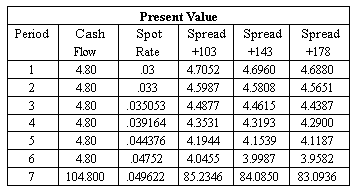Do you want BuboFlash to help you learning these things? Or do you want to add or correct something? Click here to log in or create user.
Subject 8. Yield Spreads
#basic-concepts #cfa #cfa-level-1 #fixed-income #has-images #reading-54-introduction-to-fixed-income-valuation
A bond's yield-to-maturity can be separated into a benchmark and a spread.

- Benchmark rates are usually yields-to-maturity on government bonds or fixed rates on interest rate swaps.
Changes in benchmark rates (risk-free rate of return) capture macroeconomic factors that affect all bonds in the market: inflation, economic growth, foreign exchange rates, and monetary and fiscal policy. - Changes in spreads (risk premium component) typically capture microeconomic factors that affect a particular bond: credit risk, liquidity and tax effects.
Different spread measures:
- G spread: the spread over or under a government bond rate, also known as the nominal spread. For example, suppose a 10-year, 8%-coupon bond is selling at $104.19, yielding 7.40%. The 10-year Treasury bond (6% coupon rate) has a YTM of 6.00%. Therefore, the G spread is 7.40% - 6.00% = 1.40%, or 140 basis points.
- I spread: the yield spread over or under the standard swap rate in that currency of the same tenor.
- Z spread (zero volatility spread): the constant yield spread over the benchmark spot curve such that the present value of the cash flows matches the price of the bond.
- OAS (option-adjusted spread): Z spread - option value. It is used for bonds with embedded options.
- For callable bonds and bonds with prepayment options (e.g.' most mortgage-backed and asset-backed securities), option cost > 0 and thus OAS < Z-Spread. The option cost is positive since the options are a detrimental to bondholders.
- For putable bonds, option cost < 0 and thus OAS > Z-Spread.
Example
Phil Deter was interested in purchasing a non-Treasury bond for 110.2950. Given the Treasury spot rate data below, and assuming that the non-Treasury bond had a coupon of 9.60%, what is the likely Z-spread that Phil will earn over the duration of his investment?

It is important to add all of the cash flows for each bond (discounted at the appropriate spot rate) and compare these to the purchase price by trial-and-error.
The bond with a spread of 143 Basis Points has a purchase price of 4.70 + 4.58 + 4.46 + 4.32 + 4.15 + 4.00 + 84.08 = 110.2950. Since this purchase price corresponds with the bond corresponding with Phil's interest, the appropriate spread must be 143 Basis Points.
If you want to change selection, open original toplevel document below and click on "Move attachment"
Summary
| status | not read | reprioritisations | ||
|---|---|---|---|---|
| last reprioritisation on | suggested re-reading day | |||
| started reading on | finished reading on |
Details
Discussion
Do you want to join discussion? Click here to log in or create user.